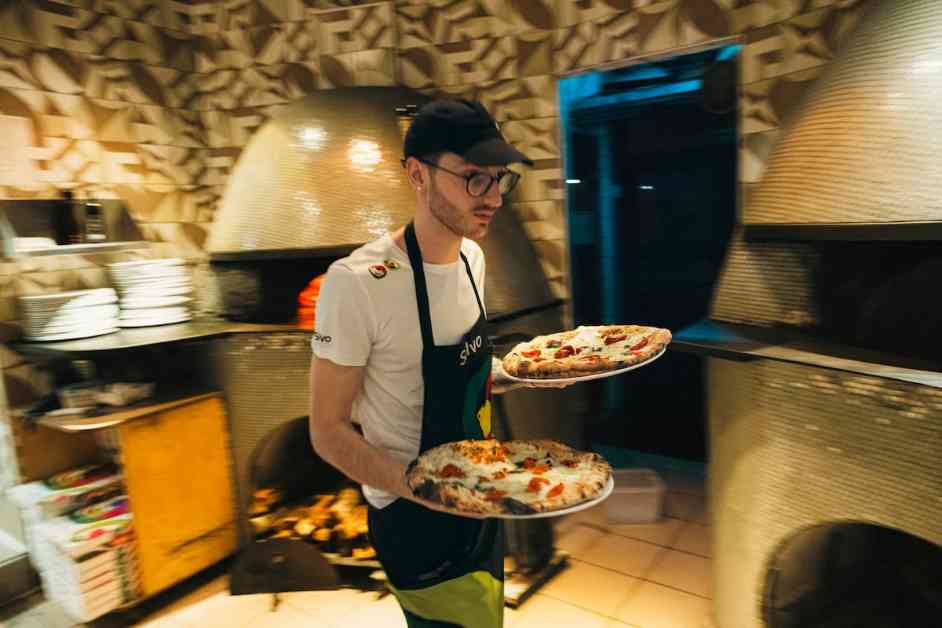The line that separates fundamentalism from integrity is often very thin. Especially for those who suffer the consequences or are not capable of the sacrifices that purity entails. On June 14, 1984, 17 men with flour-stained hands showed up at a notary near the port of Naples. The Lombardi, Capazzo, Matozzi, Pace, and Marino families had shared blood ties and hours dedicated to consecrating a secret that they passed down to their children and grandchildren. The old Neapolitan families were preparing that morning to seal an honor pact that would forever safeguard a way of seeing the world and a fundamental part of Neapolitan tradition. Antonio Pace, one of those men who lit a wood-fired oven every day with a holy card of St. Anthony protecting his fire, set out to get them to agree to sign before that notary a strict code on how authentic Neapolitan pizza should be made. Ingredients, cooking method, type of oven… Today, exactly 40 years after that meeting, the True Neapolitan Pizza Association, something like the knights of the round dough, has 1,100 members in 59 different nations. —Easy? No, quite the opposite. That same day, there were already some disputes before the notary about whether to use buffalo mozzarella or fior di latte. We had to suspend the signing for a few minutes. But we reached an agreement that lasts to this day — Pace recalls in the association’s office, right at the foot of the Neapolitan neighborhood of Capodimonte.
The notary, after a lengthy discussion that ended up validating both varieties of cheese (buffalo being of higher quality but more difficult to handle in the oven), signed the document that forever encapsulated the agreement that sanctified a way of transmitting tradition. Neapolitan pizza had to follow that document point by point. Otherwise, it could not be called as such.
The wind of radicalism purifies the arts but often also sows storms. And the first two articles of the statute opened a can of worms. The document began by demanding to safeguard the paternity of pizza for the city of Naples. And here, of course, attacks came from all over Italy. Then, it continued by emphasizing the obligation to spread the proper way of making Neapolitan pizza. “There was controversy, some did not understand it. I told them: ‘We cannot go around the world and find those pieces of bread with toppings because then we will also look bad in Naples’. Everyone had something to say. And many claimed that their pizza was also pizza. I had to refute it and argue that that was not Neapolitan pizza, that the focaccia made in the bread oven is something else. In the US, for example, they thought they had invented it. In fact, the first thing they told us when we landed in Japan was: ‘What do you call pizza in Italy?’” Pace even refuses to accept that Roman pizza is a legitimate variant. “It is an imitation of the Neapolitan one. Look, as long as you have an oven, water, and flour, you can make it. If you have talent and technique, you will have a Neapolitan pizza. Otherwise, you will have a Roman pizza,” he jokes.
At that hour, the association’s school is in full swing in the two kitchen rooms, with almost one oven for each student. Students from all over the world immerse themselves in the four-week course to become pizzaioli. Or, at least, to have the elements to enter that world consciously. Most want to open their own pizzeria, like Venezuelan Juan Carlos, living in Mexico City. Or Valeria, a Moldovan based in Northampton, who puts her advances into practice with a marinara while designing with her husband a plan for their Neapolitan pizza food truck. “We knew that this was the only place where we could truly learn the tradition,” she says as she removes the peel with a sharp stroke so the pizza is right in the middle of the oven.
The pizza’s history is a jumble of stories passed down orally. Many are legends. Others are simply fiction. And the origins are also a source of controversy in the great families of pizzaioli. The Brandi pizzeria, at one end of the Quartieri Spagnoli, boasts of having invented the Margherita pizza. But some accuse them today of going too far. The reality, or at least that told by the few history books on this subject, is that in June 1889, the cook Raffaele Esposito was summoned by Queen Margherita of Savoy to the Capodimonte palace to make three pizzas. The queen particularly appreciated one that had on its surface tomato, mozzarella, and basil (the Italian tricolor flag), which until then had been called pummarola e mozzarella. A pizza that, of course, was not made for the first time but was given the name of the queen since then. “If you want to know which is the oldest pizzeria today, you have to go see Gennaro Luciano, owner of Port’Alba,” Pace suggests before saying goodbye.
The Port’Alba, now in its fourth generation in the workshop, was already in 1738 as a laboratory where street vendors came to get pizzas to sell around the outskirts of Naples. However, in 1830, it was refounded as a pizzeria restaurant with tables and became a meeting place for writers and artists with the petite bourgeoisie. “Look, at that table over there, number 6, D’Annunzio sat with Ferdinando Russo, a composer of Neapolitan music, and bet that he wouldn’t be able to create a song in the city’s style”. From this challenge came ‘A vucchella [for a woman with full lips and shapely figure entering the door at that moment], a classic Neapolitan song that the poet and adventurer wrote on a napkin while eating pizza.
The origins of the first pizzerias, like Port’Alba itself, go back to the mid-18th century. But they weren’t even restaurants then, just rudimentary workshops with an oven and a work table where white pizzas were prepared for street vendors to pick up in their wooden boxes and distribute them, Gennaro sitting on the floor above Port’Alba explains. “They were white simply because they didn’t have tomatoes,” he points out. The pomodoro —named so because it was yellow like gold back then— was still an almost ornamental plant that some considered poisonous. “I suppose someone who wanted to commit suicide changed the course of our kitchen history,” he jokes.
The pizzas were then seasoned with strutto (a kind of dissolved pork fat), oregano, pepper, and garlic. Whoever could, added some cicinielli, small fish — sardines or anchovies — that gave it a more aromatic flavor. And that pizza, which is the first in history, was called mastunicola (supposedly after Master Nicola, the alleged inventor of that dough). “The vendors took them around and sold them in strips. Not in triangles. The portafoglio [wallet] pizza came later. It was called that because they folded them over themselves, and the boys who distributed them on the street by bicycle put them in their stufe [metal containers that kept them warm],” he explains. The pizza was then a kind of socioeconomic barometer of the city, as Alexandre Dumas recounted in Le Corricolo (1843): “With oil, with bacon, with pork lard, with cheese, with tomato, with little fish. It is the gastronomic thermometer of the market: the price increases or decreases according to the value of the mentioned ingredients, depending on the abundance or scarcity of the year.” The world has changed. Not so much the way to prepare it.
Gennaro first punches the dough with his fists to spread it; then, with his hands in a wedge shape, he opens the diameter of the dough transporting the gas from fermentation to the edges and creating a small mound that will become the famous edge of the Neapolitan pizza when the thermal shock in the oven turns that outer border into a protrusion of alveoli and small, fluffy cavities. Then he slaps the dough with flour and water to finish flattening it — the schiaffo technique was declared an intangible heritage of humanity by UNESCO — and starts adding ingredients. “Our secret? We respect tradition a lot without going overboard with innovations. We want to bring it closer to the best current products. But the pizza has to remain a meal of the people,” he says, touching on a sensitive point of the matter.
A few kilometers from Port’Alba, in the Chiaia neighborhood, is Umberto, another of Naples’ great pizzerias and one of the first to be born as a restaurant. Massimo, its owner, is the association’s vice president and a fermentation teacher at the school. Further down, next to the seafront, Salvatore Salvo (also a member of the association) runs and directs one of the world’s best pizzerias. A third-generation pizzaiolo, he is 41 years old and, along with his brothers — Ciro and Francesco — belongs to one of the great pizza dynasties. Salvatore is a black belt in tradition and respect for history. But he noticed some differences regarding the role his generation had to play. “This work was inherited, linked to the secret, to the recipe. And there was a lot of empiricism. My generation rebelled against the usual response of our parents to the question of how pizza was made: ‘It is done this way because this is how it was done,’ they told us. It was almost a religious dogma. We have studied and delved deep to improve what could be improved and protect what was fundamental. The pizza world was stagnant. We recovered what had been lost in the streets to understand our territory, our markets, our land”.
For example, the San Marzano tomato, that tasty variety shaped like a bell pepper with a bittersweet flavor, had almost disappeared due to industrial logic. But the new generations, led by pizzaioli like Salvatore Salvo, rescued it from a dying market. In that path to improve pizza quality, they ended up contributing to the industry and agriculture of the region. This is the magic of certain dishes. Today, 80% of this variety dominates pizzerias. And the best thing is that this reporter discovers all of this while perceiving how a shiny and aromatic wonder called caramella approaches him: a pizza with another variety of tomato recovered in the Vesuvius area, this time sweeter and less acidic. “We have a menu of seven different margheritas. I can tell you about the territory through this pizza, the oil, the tomato… The margherita is the Rosetta stone that allows deciphering the entire history of pizza,” says Salvo.
This pizzaiolo was the first to refine some classic rules and opened up this old universe to top chefs with Michelin stars. But he faced some criticism. “The first day, a journalist called me who didn’t even want to try them. He said, ‘Don’t allow chefs to put their hands on the pizzas, you’re offending tradition’. I took it as a challenge,” he explains as the aroma of the Cossack pizza once again captures the reporter’s attention, on the verge of succumbing to some kind of carbohydrate-induced breakout. But it matters little. Because this is another fascinating and as old as margherita. And it enters the scene covered with sprinkled pecorino, evoking the snow of Russian winter. Why? “Naples was in 1835 one of the most modern cities after Paris. And Ferdinand of Bourbon, a natural innovator, created the first train route in Italy, connecting Naples with Portici, the epicenter of his revelries. The visit of the Russian tsar that year was celebrated with the Cossack,” Salvo points out.
Authentic Neapolitan pizza has changed little in its basic technique. But there is no doubt, on the other hand, about the modernity that the emergence of its fried side implied. A modality born after World War II when Naples was suffering, and its inhabitants were struggling to find the necessary products. Many of the wood-fired ovens and their chimneys had also been destroyed by bombings. Faced with adversity, some women began to fry that dough and fill it with other types of cheeses easier to obtain, like ricotta, to then sell it at the door of their homes, just like the unfaithful Sophia Loren in The Gold of Naples (1954), by Vittorio De Sica. “Eat today and pay in eight days,” she shouted in the film. A real commercial technique — they called it pizza a otto — that allowed many people who didn’t have enough money to return the following week to pay and take another. And that’s how the jewel of what we now call street food was born.
Today, great masters of this genre survive in Naples, like Paolo Surace, the general secretary of the True Neapolitan Pizza Association and a pizzaiolo turned into a real showman who preserves his family’s tradition. The dough of the fried side is the same as the other, but with a little less flour, more hydrated, so that it swells more easily when it comes into contact with the boiling oil (between 180 and 230 degrees). “My father said that fried pizza was a science, but also love. I listened to his stories. And that’s how I learned to love this job,” he recalls as a Japanese couple watches from the small window that overlooks the street. The dough begins to float in the oil and take on an extremely suggestive shape. Inside, the ricotta and the ciciolli —a kind of cracklings— begin to cover all the nooks and crannies of this gastronomic marvel to which the reporter, with enthusiasm and little digestion capacity left, will surrender to fulfill professional rigor. Everyone has their principles.
“Neapolitan pizza has no inventors, no parents, and no owners. It is only the fruit of the genius of the Neapolitan people,” Antonio Pace, president of the association, often says. However, whether traditional or fried, they do have their guardians. A rigidity that also finds detractors. But today, 40 years after that meeting in a notary’s office at the port, no one can say they didn’t know how authentic Neapolitan pizza should be made.












